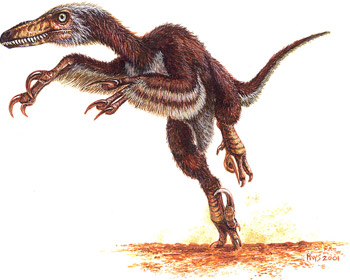
Reconstruction of the new Triassic carnivorous dinosaur Tawa hallae. Tawa was discovered by Sterling Nesbitt and colleagues at Hayden Quarry in northern New Mexico. (Photo Credit: Illustration by Jorge Gonzalez)

Reconstruction of the new Triassic carnivorous dinosaur Tawa hallae. Tawa was discovered by Sterling Nesbitt and colleagues at Hayden Quarry in northern New Mexico. (Photo Credit: Illustration by Jorge Gonzalez)

Headlines like this have a way of being tossed aside by evolutionists themselves within a few years, yet the constant media barrage makes it seem like evolution is constantly proven and unchallengeable.
Take, for example, the characterization of this dinosaur as 'primitive.' I virtually never see objective evidence presented to justify an assessment of any particular fossil as 'primitive'. And behind the headlines, the typical pattern is for expert assessments to recognize that 'primitive' fossils actually show specialization and high levels of adaptation to their environment, in contradiction to the public pronouncements of about being 'primitive.'

So according to these claims the earliest dinosaurs developed in the same area as the Roswell UFO crash? Maybe the aliens were returning to check out results of their species development experiments. The truth is out there, ha ha ha
|
|
|||
Gods |
Thanks JoeProBono and Fractal Trader. |
||
|
· Discover · Nat Geographic · Texas AM Anthro News · Yahoo Anthro & Archaeo · Google · · The Archaeology Channel · Excerpt, or Link only? · cgk's list of ping lists · |
|||
BTW, the following blog post reveals more about how this new fossil clarifies early dinosaur evolution, and why in particular it points to South America as the point of origin:
scientificblogging.com/news_articles/tawa_hallaenew_theropod_dinosaur_alters_evolutionary_tree
What the Tawa hallae discovery reveals about another dinosaur, Herrerasaurus, the center of a lively debate since its discovery in Argentina in the 1960s, may prove to be quite significant.
Herrerasaurus had some traits in common with theropods—including large claws, carnivorous teeth and certain pelvic features—but lacked other theropod traits such as pockets in vertebrae for airsacs. Some paleontologists claimed it was so unusual it was outside the evolutionary tree of theropods, or even of dinosaurs. Others placed it among the earliest theropods.
"The question was did those carnivorous traits arise in Herrerasaurus and in theropods independently or were they traits from a recent common ancestor that got passed down," said Sterling Nesbitt, lead author of the Science paper. "We had so few specimens of early theropods that it was hard to answer that question. But now that we have Tawa, we think we have an answer."
Tawa had a mix of Herrerasaurus-like characteristics (for example, in the pelvis) and features found in firmly established theropod dinosaurs (for example, pockets for airsacs in the backbone). Therefore, the characteristics that Herrerasaurus shares uniquely with theropods such as Tawa confirm the characteristics didn't arise independently and that Herrerasaurus is indeed a theropod.
The firm placement of Herrerasaurus within the theropod lineage points up an interesting fact about dinosaur evolution: once they appeared, they very rapidly diversified into the three main dinosaur lineages that persisted for more than 170 million years. Herrerasaurus was found in a South American rock layer alongside the oldest members of two major lineages—the sauropods and the ornithischians.
"Tawa pulls Herrerasaurus into the theropod lineage, so that means all three lineages are present in South America pretty much as soon as dinosaurs evolved," said Nesbitt. "Without Tawa, you can guess at that, but Tawa helps shore up that argument."